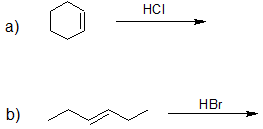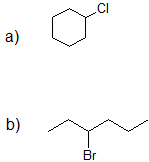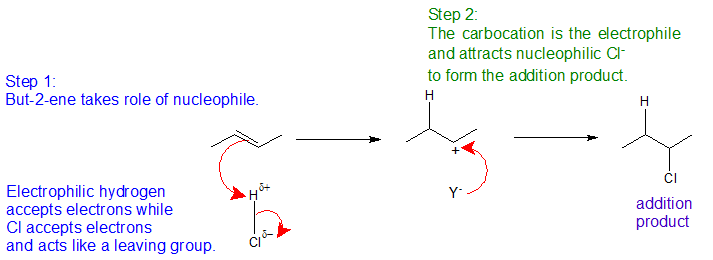The addition of hydrogen halides is one of the easiest electrophilic addition reactions because it uses the simplest electrophile: the proton. Hydrogen halides provide both a electrophile (proton) and a nucleophile (halide). First, the electrophile will attack the double bond and take up a set of π electrons, attaching it to the molecule (1). This is basically the reverse of the last step in the E1 reaction (deprotonation step). The resulting molecule will have a single carbon- carbon bond with a positive charge on one of them (carbocation). The next step is when the nucleophile (halide) bonds to the carbocation, producing a new molecule with both the original hydrogen and halide attached to the organic reactant (2). The second step will only occur if a good nucleophile is used.
All of the halides (HBr, HCl, HI, HF) can participate in this reaction and add on in the same manner. Although different halides do have different rates of reaction, due to the H-X bond getting weaker as X gets larger (poor overlap of orbitals)s.
Reaction rates
Variation of rates when you change the halogen
Reaction rates increase in the order HF < HCl < HBr < HI. Hydrogen fluoride reacts much more slowly than the other three, and is normally ignored in talking about these reactions.
When the hydrogen halides react with alkenes, the hydrogen-halogen bond has to be broken. The bond strength falls as you go from HF to HI, and the hydrogen-fluorine bond is particularly strong. Because it is difficult to break the bond between the hydrogen and the fluorine, the addition of HF is bound to be slow.
Variation of rates when you change the alkene
This applies to unsymmetrical alkenes as well as to symmetrical ones. For simplicity the examples given below are all symmetrical ones- but they don't have to be.
Reaction rates increase as the alkene gets more complicated - in the sense of the number of alkyl groups (such as methyl groups) attached to the carbon atoms at either end of the double bond. For example:

There are two ways of looking at the reasons for this - both of which need you to know about the mechanism for the reactions.
Alkenes react because the electrons in the pi bond attract things with any degree of positive charge. Anything which increases the electron density around the double bond will help this.
Alkyl groups have a tendency to "push" electrons away from themselves towards the double bond. The more alkyl groups you have, the more negative the area around the double bonds becomes.
The more negatively charged that region becomes, the more it will attract molecules like hydrogen chloride.
The more important reason, though, lies in the stability of the intermediate ion formed during the reaction. The three examples given above produce these carbocations (carbonium ions) at the half-way stage of the reaction:

The stability of the intermediate ions governs the activation energy for the reaction. As you go towards the more complicated alkenes, the activation energy for the reaction falls. That means that the reactions become faster.
Exercise
1. Draw the bond-line structures for the products of the following reactions.

- Answer
-
1.







